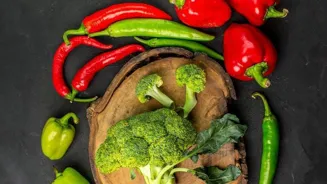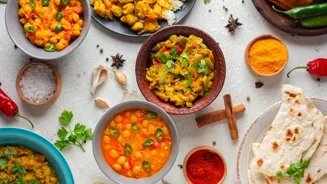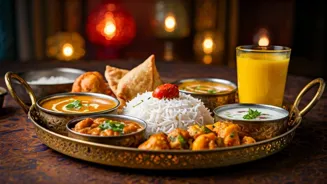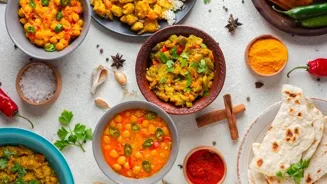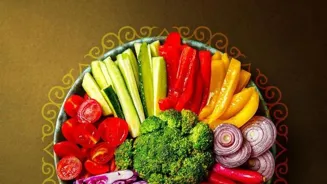Discover the art of perfect tandoori vegetables with 6 expert tips! Elevate your grilling game and tantalize your taste buds
Namaste, food lovers! With winter slowing inching away and the sun peeping out
more often, it's time to dust off those grills and get ready for some flavourful tandoori vegetables.
Tandoori cooking, traditionally done in a clay oven (tandoor), gives vegetables a smoky char and delicious taste, making them simply irresistible. But don't worry if you don't have a tandoor! You can achieve amazing results with your home oven, grill, or even a sturdy pan on the stovetop.
Today, we share six simple tips to help you master the art of tandoori vegetables, ensuring perfect grilling every time. Get ready to impress your family and friends with these flavour-packed delights!
Choosing the Right Veggies: It's All About Texture!
The key to great tandoori vegetables lies in selecting produce that can withstand the high heat and absorb those wonderful marinades. Look for vegetables that are firm and slightly dense. Think about the texture you want after grilling.
Some popular choices include cauliflower (gobhi), broccoli, bell peppers (shimla mirch), onions, potatoes, paneer (Indian cheese), mushrooms, and even chunks of pineapple for a sweet and tangy twist.
Avoid vegetables that are too soft or watery, as they might become mushy during the grilling process. A good rule of thumb is to choose a colourful mix of vegetables, not only for visual appeal but also for a variety of flavour profiles that will tantalise your taste buds.
Make sure your veggies are washed thoroughly and cut into similar-sized pieces. This is important because uniform sizes help in even cooking, so you don't have some pieces being burnt while others still remain undercooked. Nobody wants a crunchy cauliflower and a soft potato, right?
The Magic of Marinade: The Flavour Foundation!
The marinade is where the magic truly happens. This is where you infuse your vegetables with all those incredible tandoori flavours. A good tandoori marinade usually consists of yogurt (dahi), ginger-garlic paste, lemon juice, and a blend of spices.
The yogurt tenderises the vegetables, while the ginger-garlic paste adds a pungent aroma and depth of flavour. Lemon juice helps to balance the richness and adds a touch of tanginess. As for the spices, that's where you can get really creative!
Common tandoori spices include turmeric (haldi), red chilli powder (lal mirch), coriander powder (dhania), cumin powder (jeera), garam masala, and a pinch of ajwain (carom seeds). Don't be afraid to experiment with different spice combinations to create your own signature tandoori flavour.
Remember to adjust the amount of red chilli powder based on your spice preference. A little hing (asafoetida) can also add a nice savoury note to your marinade.
Marinating Time: Patience is a Virtue!
Once you have prepared your marinade, it's crucial to give your vegetables enough time to soak up all those flavours. The longer you marinate them, the more flavourful and tender they will become.
Ideally, you should marinate your vegetables for at least 30 minutes, but for best results, aim for 2-3 hours, or even overnight in the refrigerator. If you're marinating overnight, make sure to cover the vegetables tightly to prevent them from drying out.
This extended marinating time allows the yogurt and spices to penetrate the vegetables, resulting in a deeper and more complex flavour profile. Trust me, this step is worth the wait! Imagine biting into a piece of perfectly grilled cauliflower, bursting with flavour from the inside out.
That's the power of a good marination! Also, don't overcrowd the container while marinating because, doing so will not allow all vegetables to marinates. Marinade in batches if required.
Grilling Techniques: Heat Control is Key!
When it comes to grilling your tandoori vegetables, heat control is essential. Whether you're using an oven, grill, or stovetop, make sure to preheat it properly. For oven grilling, set the temperature to high and place the vegetables on a baking sheet lined with aluminium foil.
This makes cleaning up much easier later on. For grilling on a barbecue, use medium-high heat, and be sure to oil the grill grates to prevent the vegetables from sticking. On a stovetop, use a heavy-bottomed pan or a cast-iron skillet, and heat it over medium-high heat.
Arrange the marinated vegetables in a single layer, leaving some space between them. This will ensure that they cook evenly and develop that desirable char. Turn the vegetables occasionally to prevent them from burning.
The cooking time will vary depending on the type of vegetables you're using and the heat of your grill. Just keep a close eye on them and cook until they are tender and slightly charred. A light brush of oil while grilling adds a beautiful sheen and prevents them from drying out.
The Smoky Touch: Adding that Authentic Flavour!
What truly sets tandoori vegetables apart is that delicious smoky flavour. If you don't have a traditional tandoor, you can still achieve that smoky taste at home! One simple trick is to use a piece of charcoal. Heat a piece of charcoal on the stovetop until it turns red-hot.
Place it in a small steel bowl and carefully place the bowl in the middle of your grilled vegetables. Pour one teaspoon of ghee or oil over the hot charcoal. This will create a cloud of smoke. Immediately cover the vegetables with a lid to trap the smoke inside.
Let it sit for a few minutes, allowing the smoke to infuse the vegetables with that authentic tandoori flavour. This is a great way to add that extra layer of flavour that will impress everyone.
Be very careful while handling the hot charcoal and ensure that it is completely extinguished before disposing of it.
Serving Suggestions: The Final Flourish!
Your tandoori vegetables are ready! Now it's time to showcase your culinary creation. Serve the hot, smoky vegetables immediately, garnished with fresh coriander leaves (dhaniya) and a squeeze of lemon juice.
A sprinkle of chaat masala adds a tangy and spicy kick that complements the tandoori flavours perfectly. Tandoori vegetables are incredibly versatile and can be enjoyed as a standalone appetizer, a side dish, or even as a filling for wraps and sandwiches.
Pair them with mint chutney or raita (yogurt dip) for a refreshing contrast. They also make a fantastic addition to salads and can be used as a topping for pizzas or flatbreads. The possibilities are endless!
Don't forget to have fun and experiment with different pairings to create your own unique culinary experience. So, go ahead, fire up your grill and get ready to enjoy some delicious and healthy tandoori vegetables! Happy grilling!


